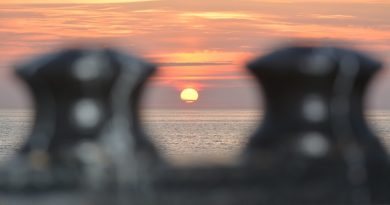Treacherous conditions plague cleanup of sunken vessel in Southwest Alaska

(Courtesy Alaska Department of Fish and Game / Alaska Dispatch)
A month has passed and the 78-foot vessel the Lone Star is still lying capsized in the Igushik River, slowly leaking fuel into salmon-producing waters at the mouth of Bristol Bay, as salvage crews work in rushing currents and zero visibility on one of the most dangerous operations of their careers.
Images of the Lone Star show a vessel lying on its side in relatively shallow waters, which fluctuate between 5 and 30 feet deep, depending on the tide. But what at first glance seems to be a simple salvage process is actually a treacherous operation, thanks to Alaska’s extreme nature.
Ray Fortin, salvage master with Resolve Marine, said the Lone Star is one of the “more dangerous” operations that he’s overseen in his 18 years on the job. Fortin, based out of Montreal, has traveled around the world conducting salvage operations.
“Normally with a salvage you have a danger to contend with — cold water, extreme currents, extreme tides, remoteness of operation,” Fortin said. “With this salvage operation, it pretty much covers all the angles.”
The Lone Star capsized early in the morning on June 30, when the changing tide reportedly swung the anchored ship into its anchor chain, which caught on the transducer and coolant lines, pulling them loose and creating a hole in the boat’s steel hull.
The boat has remained underwater since, slowly leaking fuel and causing a month-long closure of the commercial set net salmon fishery on the river.
Magone Marine and Resolve Marine Group have been working together to remove the ship from the water. They are tasked with removing all of the diesel fuel from the ship — an estimated 14,000 gallons — before positioning the vessel upright and moving it out of the water.
But the operation has stretched out for a month so far and may continue for a week or more, due to extreme conditions.
First, there’s the current, which can flow “in excess of 7 knots,” Fortin said, or more than 8 mph. The current is so strong divers can spend only 90 minutes in the water per dive. As the tide changes direction, the current slows and reverses. That means dives can be conducted only two to three times a day, and the operation has to be pieced together from one dive to the next.
As the tide changes, divers will tell the crew “that it’s getting harder and harder just to hold on,” Fortin said.
Second, there’s the fact that divers are working blind. Zero-visibility conditions in the silt-laden waters means the diver is literally feeling his way around the ship and reporting back to the rest of the crew via headset.
Fortin said the layout of the ship quickly becomes familiar, however. Divers have a model of the vessel to work from, but eventually even “the smallest things” become imprinted in their mind’s eye.
Then, there’s the freezing water. Dry suits aren’t enough to withstand the frigid waters of the Igushik River, so divers wear hot suits, which are connected via umbilical cord to the salvage crews’ ship, and continually circulates hot water to keep the diver warm.
Regardless of the extreme environmental conditions, “divers are handling it very well,” Fortin said. They are mentally prepared for the challenge and understand going into the dive the dangers inherent in their line of work.
Diver Joe Lesure takes the danger of the salvage operation in stride. “It’s just another day for us,” he said. Based out of New Orleans, Lesure works all over the world, “wherever there’s water.”
Given the dangerous conditions, safety is the salvage crews’ first concern. “We are not taking any chances,” Fortin said. Only one diver of the seven on the team heads out during a dive, while the rest of the crew helps coordinate from the ship, ensuring the divers’ safety during the operation.
Monday evening’s dive turned up a new challenge for the crew, as well: currents have washed away the mud from the sides of the ship, and the vessel is now resting on a mound of sand. That means the vessel could shift off the mound during a dive operation and potentially crush the diver.
Lesure discovered the problem while doing an inspection dive, “feeling around” in the mud. He likened the experience of inspecting a ship in zero visibility to being used as a “tool” for the salvage crew.
This discovery forced a change of plan for the salvage crew, and divers are no longer working in the area where the ship could tumble. Now, the vessel will need to be rolled upright before the remaining tanks, holding about 3,600 gallons of fuel, can be emptied.
To remove the fuel, divers drill into the tanks and extract the fuel one tank at a time. To calculate where they need to drill, they start at the keel — the bottom of the ship. From there, they connect a line to the keel and stretch it out. The line has knots in it which designate exactly where the tanks are located. A diver can then start the drilling process.
To access some tanks, divers sometimes use water jets to create tunnels underneath the mud — all with zero visibility — before beginning drilling. No fuel is spilled during the extraction process, and fuel is pumped onto a neighboring barge.
How much fuel has leaked from the wreckage won’t be known until it is all sucked from the ship and its quantity compared to how much was reported on the ship. Steve Russell, environmental program manager with the Alaska Department of Environmental Conservation said that “very small amounts” are leaking and it’s washing a few hundred yards from the boat. “There is some periodic, intermittent sheen” visible on the river.
Once the ship is moved upright and emptied of fuel, 3,500 pounds of salmon still being held on the Lone Star will need to be examined, flushed of any fuel contamination, and disposed of. How they will be disposed depends on the level of contamination and other environmental conditions, including whether whales are in the area.
“We don’t want to dump 3,500 pounds of decaying salmon in front of a pod of belugas,” Russell said.
If the fuel is in good condition, it will be reused or recycled, Russell said. If not, the Lone Star’s owner will have to take measures to dispose of it.
Contact Laurel Andrews at laurel(at)alaskadispatch.com



